Spotty Gas Giants, and Monday’s Full Sturgeon Moon is Blue and Super, Moseys Past Evening Saturn and then Meets Pre-dawn Pleiades!

My friend Andrea Girones of Ottawa captured and processed this spectacular view of the sun’s complete disk while attending the annual Starfest gathering on August 7, 2024. It beautifully captures the sun’s convection cell pattern, the dark elongated filaments and the prominences they become when viewed in profile around the sun’s limb (especially at right), the bright, extra-hot, white plage regions, and the numerous sunspots that are responsible for the recent heightened auroral activity on Earth. You can see her image in more detail, and additional views of the sunspots in filtered white light, on her Instagram post at https://www.instagram.com/p/C-bvx7lsL8g/?img_index=1
Hello, Waning-summer Stargazers!
Here are your Astronomy Skylights for the week of August 18th, 2024 by Chris Vaughan. Feel free to pass this along to your friends and send me your comments, questions, and suggested topics. You can also follow me on Twitter as @astrogeoguy! Unless otherwise noted, all times are expressed in Eastern Time. To subscribe to these emails please click this MailChimp link.
If you’d like me to bring my Digital Starlab portable inflatable planetarium to your school or other daytime or evening event in Simcoe, Grey, and Bruce Counties, or deliver a virtual session anywhere, contact me through AstroGeo.ca, and we’ll tour the Universe, or the Earth’s interior, together! My book with John A. Read entitled 110 Things to See With a Telescope is a guide to viewing the deep sky objects in the Messier List – for both beginners and seasoned astronomers. DM me to order a signed copy!
The full moon that happens on Monday night will be a seasonal blue moon and the first of four supermoons. Can you tell it’s bigger and brighter? For the rest of the week, the moon will rise later and wane in phase – posing with bright Saturn on Thursday night – but the moon won’t clear out of the evening sky until next week. Venus continues to lurk in the west after sunset, Neptune chases Saturn across the sky all night, and Mars and Jupiter shine farther apart in the east from the wee hours until dawn. Read on for your Skylights!
The Blue Super-ish Moon
For mid-northern latitude residents, the sun is setting at about 8:15 pm local time this week. That time is advancing by about 1.5 minutes per day, but that rate will accelerate as we approach the first day of fall on the September equinox a month from now! The increasingly earlier sunsets let us see the stars of summer deep into autumn. They’ll also deliver lots of moonlight in the evening sky this week because the moon will be rising not long after the sun sets.
Tonight (Sunday) the 99%-illuminated, waxing gibbous moon will rise in the southeast as the sun is setting in the west-northwest. The brilliance of the moon all night long will obscure the lack-lustre stars of Capricornus (the Sea-Goat) that surround it and wash out the summer Milky Way off to its right.
The full moon of August will occur on Monday, August 19 at 2:26 pm EDT, 11:26 am PDT, or 18:26 Greenwich Mean Time. (Everyone on Earth sees the same moon phase once it rises in their own local time zone.) In the Americas, the full moon will remain usually low as it crosses the sky because it will be travelling about 4 degrees below the already low summertime ecliptic. Even when it is highest, due south at 2 am, you might need to walk around a bit to spot it shining between trees or buildings.
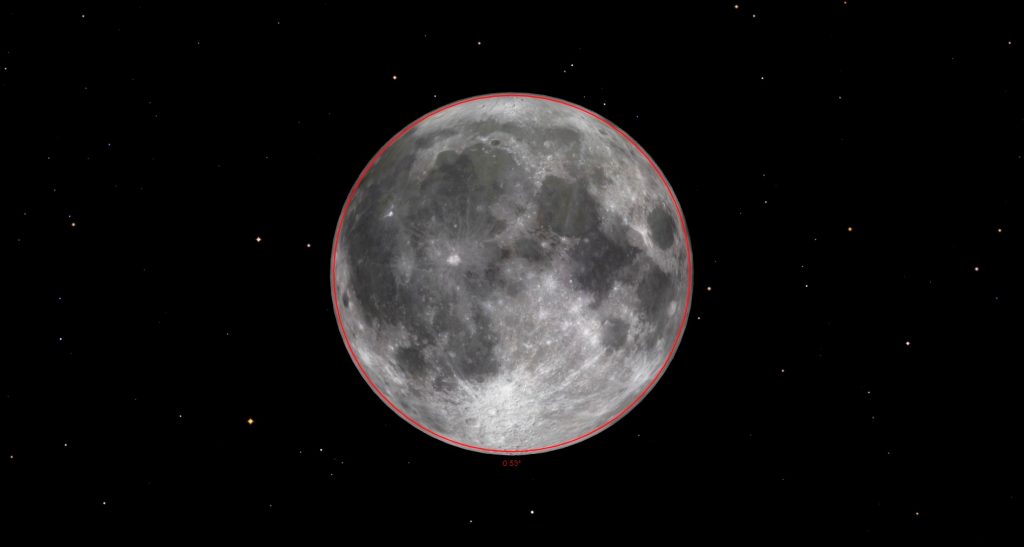
The August, 2024 full moon will be special for two additional reasons – it’s a “blue moon” and a “supermoon”. In a calendar year, the moon completes 12.36 cycles of its phases, also known as its synodic period. That means that every third year (give or take) contains 13 full moons instead of 12. The extra full moon is called “blue” if either a) it’s the third full moon out of four within a season, or b) it’s the second full moon within the same calendar month. Tomorrow’s is the third full moon to occur during summer, 2024, so it’s a blue moon type a), or a seasonal blue moon. The other type of blue moon is my preferred one. Astronomers don’t make a fuss about blue moons, but the media like to do that. What is important to remember is that blue moons DON’T LOOK BLUE! Instead, you’ll probably observe that tonight’s moon is tinted brown or orange by the forest fire smoke particles in the air. (The smoke also spoils stargazing by dimming everything.)
This full moon will also occur 35 hours before its monthly perigee, making this the first in a series of four supermoons in 2024 – appearing about 7% larger and shining a bit brighter than average. Since the September and October full moons will be the most super of this year, I’ll share more details about supermoons next month.
The August full moon, colloquially called the Sturgeon Moon, Red Moon, Green Corn Moon, and Grain Moon – all names reflecting what nature is up to at this time of year – always shines among or near the stars of Aquarius or Capricornus. The indigenous Anishinaabe people of the Great Lakes region call it Manoominike-giizis, the Wild Rice Moon, or Miine Giizis, the Blueberry Moon. The Cree Nation of central USA and Canada calls the August full moon Ohpahowipîsim, the Flying Up Moon. The Haudenosaunee (Iroquois) of Eastern North America call it Seskéha, the Freshness Moon.
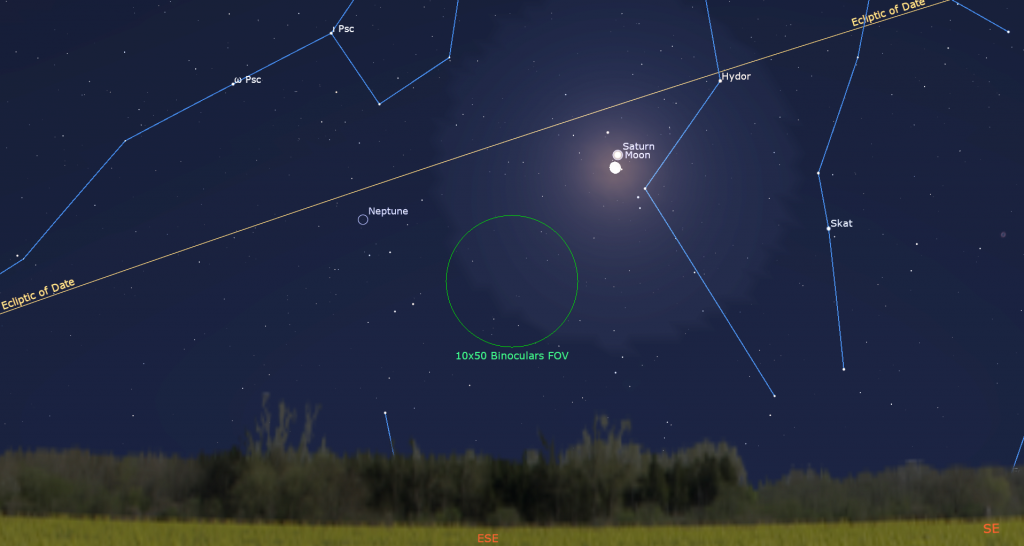
Monday night’s moon will be accompanied by the prominent, yellowish dot of Saturn shining more than a fist’s diameter off to its left (celestial east). Both objects will be within the borders of Aquarius (the Water-Bearer). The moon itself will appear just slightly less than full – its eastern (right-hand) edge will be darkened.
You’ll see the bright waning, gibbous moon and Saturn huddled close together when they clear the treetops in the east around 10 pm local time on Tuesday. Over the course of the night, the pair will cross the sky together. Meanwhile the moon’s eastward orbital motion and the diurnal rotation of the sky will pull the moon farther from Saturn and rotate the ringed planet below the moon. Watch for them low in the southwestern sky before sunrise on Wednesday morning. Observers in a zone across northern South America and across the Atlantic Ocean to northwestern Africa and western Europe can watch the moon pass in front of (or occult) Saturn on Tuesday evening around 02:00 GMT.
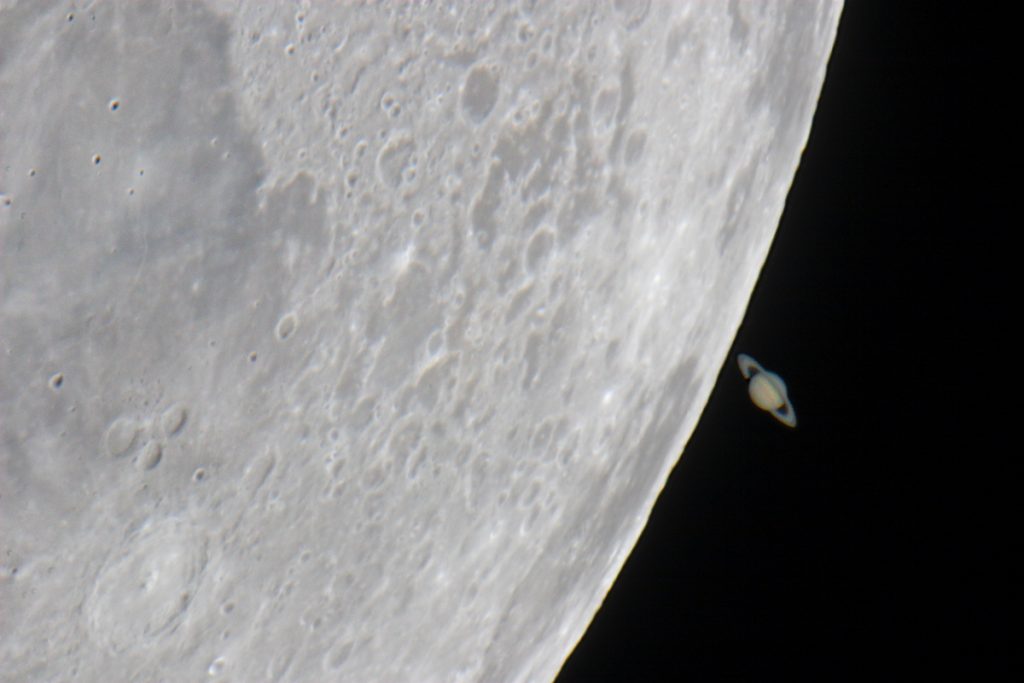
The moon will continue to slide east away from Saturn, wane in phase, and rise about 20 minutes later each night. It will spend Wednesday and Thursday swimming through Pisces (the Fishes) and Friday and Saturday night visiting Aries (the Ram). Since it will be rising around 10 pm local time by then, it will still be spoiling the fun of us stargazers. At this time of the lunar month, the moon lingers into the morning daytime sky, too.
Next Sunday night, the moon will have waned to a bit more than half-illuminated and will rise around 11 pm. Aim your binoculars just above the moon to see the sprinkling of the stars of the bright little Pleiades star cluster, aka the Seven Sisters and Messier 45. The “sisters” will be farther from the moon for observers viewing them later or in more westerly time zones. The planet Uranus will be located several finger widths to the right of the moon.

After next Sunday night’s third quarter moon, we’ll finally return to dark evening skies!
The Planets
Although Venus is continuing to increase its angle from the sun every day, it remains stubbornly pinned above the western horizon after sunset for those of us viewing it from mid-northern latitudes. If your western horizon is unobstructed and free of cloud or haze, you can start to look for Venus’ very bright dot starting around 8:30 pm local time. The planet will be the only bright, star-like object less than a palm’s width above the horizon. If you see a bright speck moving left or right, it’s an aircraft. Wait until the sun has fully set before using binoculars. Folks living closer to the tropics are already easily seeing Venus gleaming between the palm trees after sunset. As we approach the September equinox, she will start to climb higher and become our brilliant “Evening Star” gleaming high in the western sky throughout fall and winter.
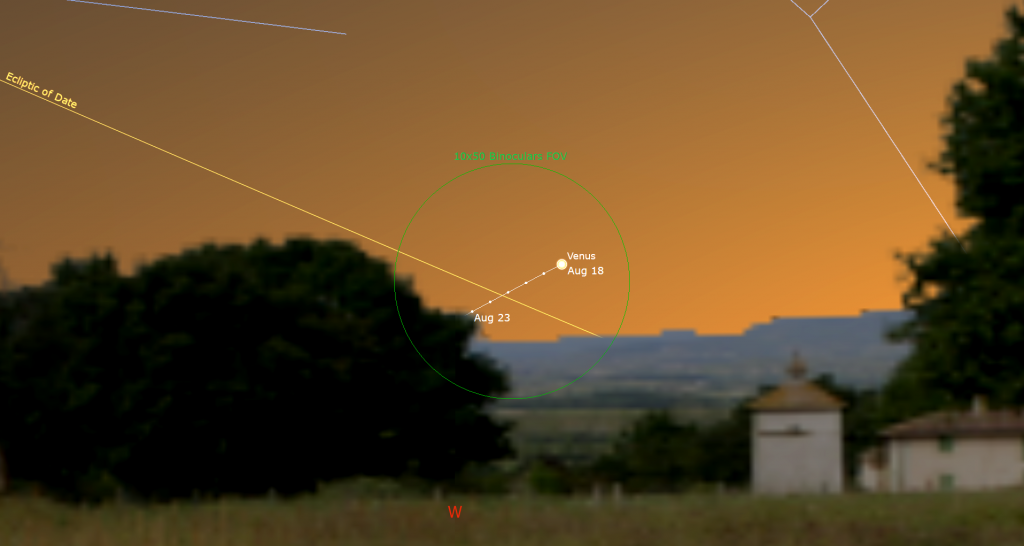
I mentioned above that the moon will pose near Saturn during several nights this week, and that the moon will fully occult Saturn on Tuesday evening for those located in northern South America and on Wednesday morning for folks in northern Africa and Western Europe. Lunar occultations of stars and planets are perfectly safe to look at, especially in binoculars and telescopes.
Saturn will hold court in the late evening and overnight sky worldwide for many months to come. This week, the ringed planet will rise by about 9 pm local time and then remain in view as a bright “star” in the lower part of the southwestern sky before sunrise. Saturn will spend the next 10 months drifting among the rather faint stars of Aquarius (the Water-Bearer). Binoculars will show you a bent-line trio of stars named Psi Aquarii sparkling to Saturn’s lower right. The lower two are white, while the higher one is golden. Two redder stars named Phi and Chi Aquarii will appear to Saturn’s upper and lower right, respectively.
Saturn’s rings, which will effectively disappear when they become edge-on to Earth next March, already appear as a thick line drawn through the planet’s globe. Good binoculars can hint that Saturn has rings, and any size of telescope will show them, plus Saturn’s moons! I’m used to seeing Saturn’s moons sprinkled all around the planet – unlike Jupiter’s Galileans moons, which form a line. But Earth’s perspective of the Saturn system this year and next year will put its moons in a line with the rings.
Saturn’s largest and brightest moon Titan never wanders more than five times the width of Saturn’s rings from the planet. The much fainter moon named Iapetus can stray up to twelve times the ring width during its 80-day orbit of Saturn. The next brightest moons Rhea, Dione, Tethys, Enceladus, and Mimas all stay within one ring-width of Saturn.
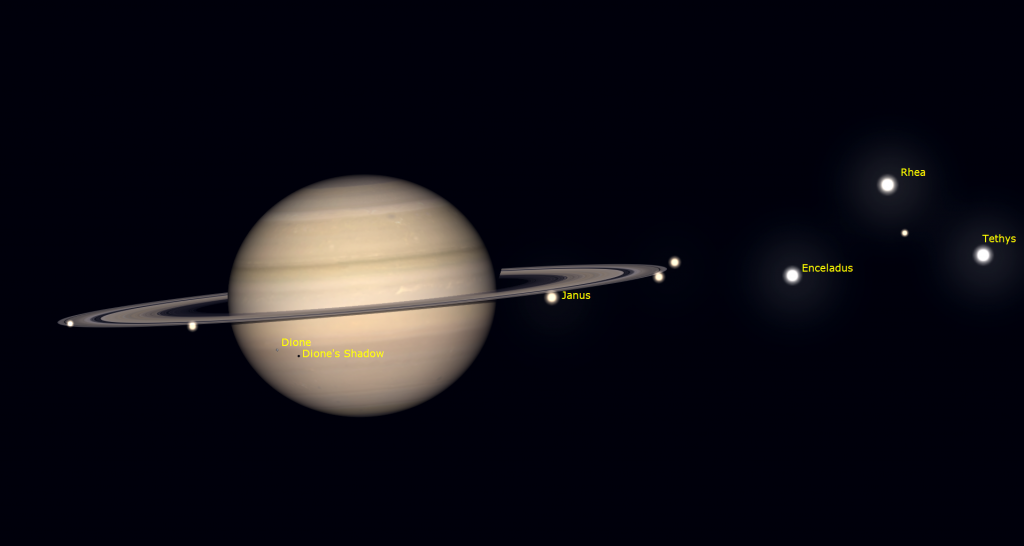
During this week, Titan will move from Saturn’s upper right (celestial west) tonight to a bit farther in the same direction on Monday and Tuesday, then inward to just above the planet on Saturday night and just to Saturn’s left (celestial east) on next Sunday night. (Remember that your telescope will probably flip the view around.) The rest of the moons will be tiny specks in a line beyond the rings. You may be surprised at how many you can see through your telescope if you look closely.
Earth’s perspective of the Saturn system will also cause Saturn’s moons and their small black shadows to frequently cross its disk – but you’ll need a very high quality telescope to watch those. Rhea and its shadow will cross Saturn’s southern hemisphere on Wednesday morning from 12:00 to 2:45 am EDT. Dione and its shadow will cross Saturn’s southern hemisphere on Thursday night from 11:20 pm to 2:15 am EDT.
Neptune will rise 20 minutes after Saturn and follow it across the sky every night. The remote, blue planet will be spending this year in western Pisces (the Fishes), a generous fist’s width to the lower left (or 11° to the celestial ENE) of Saturn. Neptune doesn’t move very quickly through the stars. It will be located a bit more than a thumb’s width to the upper left (or 2° north) of a medium-bright star named 27 Piscium, allowing them to share the view in binoculars. Other less-brilliant stars nearby named 29 Piscium, 24 Piscium, and 20 Piscium will help guide you to Neptune with a backyard telescope or good, strong binoculars. For now, the best time to look at Neptune is while it’s higher up and the sky is dark – between about 11:30 pm and 5:30 am local time.
Uranus will rise around 11:30 pm this week – but it won’t climb high enough for viewing until about 1:30 am local time. It’ll rise about 30 minutes earlier every week, but you could alternatively head outside with binoculars or a backyard telescope before 5:30 am if you are keen to see it now. Personally, I’ll wait a month! In binoculars and a backyard telescope Uranus will appear as a dull, non-twinkling, blue-green star positioned about a palm’s width to the lower right of the bright Pleiades star cluster.
In a few weeks, Jupiter will begin to rise before midnight – kicking off a nine month engagement in the evening sky. For now, the giant planet will rise at about 12:45 am local time and then gleam in the east until sunrise. The reddish dot of 16 times fainter Mars has been cruising near Jupiter for several weeks. Last Wednesday they met in a spectacular close conjunction. Now, Mars’ relatively faster easterly orbital motion is pulling Mars farther to the lower left of Jupiter each morning. Both planets are shining in Taurus (the Bull), between the critter’s horns and a fist’s width to the left (or 9° to the celestial ENE) of his brightest star, reddish Aldebaran.
Binoculars will show Jupiter’s four Galilean moons named Io, Europa, Ganymede, and Callisto lined up beside the planet. Those moons complete orbits of the planet every 1.7, 3.6, 7.2, and 16.7 days, respectively. If you see fewer than four moons, then one or more of them is crossing in front of or behind Jupiter, or hiding in Jupiter’s dark shadow – or two of the moons are very close together, or one moon is eclipsing or occulting another one.
Even a small, but decent quality telescope can show you Jupiter’s dark belts and light zones, which are aligned parallel to its equator. With a better grade of optics, Jupiter’s Great Red Spot, a cyclonic storm that has raged for hundreds of years, becomes visible for several hours when it crosses the planet every 2nd or 3rd night. For observers in the Americas, that GRS will cross Jupiter’s disk in the wee hours of Monday, Wednesday, and Saturday, and before dawn on Friday and next Sunday morning. If you have any coloured filters or nebula filters for your telescope, try enhancing the spot with them.
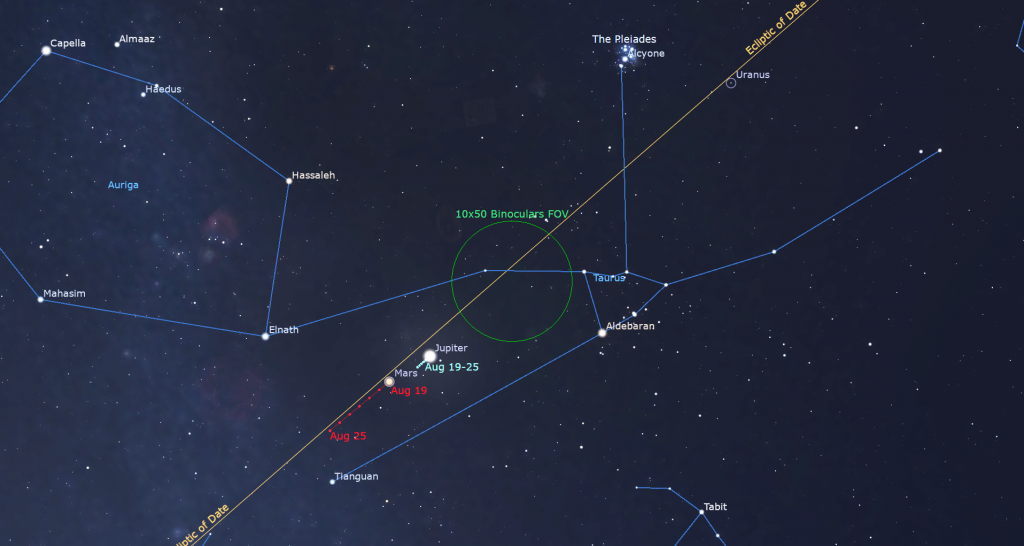
From time to time, observers with good quality telescopes can watch the black shadows of the Galilean moons travel across Jupiter’s disk. On Friday morning, august 23, the black shadow of Io will travel across Jupiter from 1:05 to 3:12 am EDT.
In a telescope, Mars will display a small, rusty-coloured disk. Its position on the far side of the sun from Earth is keeping the planet looking small until later this year. If you do check it out, take notice that Mars is only 88%-illuminated because its angle from the sun is 68°.
Public Astronomy-Themed Events
Every Monday evening, York University’s Allan I. Carswell Observatory runs an online star party – broadcasting views from four telescopes/cameras, answering viewer questions, and taking requests! Details are here. They host in-person viewing on the first clear Wednesday night each month. Other Wednesdays they stream views online via the observatory YouTube channel. Details are here.
On Saturday, August 24 from 10 pm to midnight, RASC Toronto Centre will host Family Night at the David Dunlap Observatory for visitors aged 7 and up. You will tour the sky, visit the giant 74” telescope, and view celestial sights through telescopes if the sky is clear. This program runs rain or shine. Details are here, and the link for tickets is at ActiveRH.
On Sunday afternoon, August 25 from 12:30 to 1:30 pm EDT, head to the David Dunlap Observatory for in-person DDO Sunday Sungazing. Safely observe the sun with RASC Toronto astronomers! During the session, which is for ages 7 and up, a DDO Astronomer will answer your questions about our closest star – the sun! Registrants will be given an eclipse viewer, learn how the sun works and how it affects our home planet, view the sun through solar telescopes, weather permitting, and visit the giant 74” telescope. More information is here and the registration link is here.
Keep your eyes on the skies! I love getting questions and requests. Send me some!